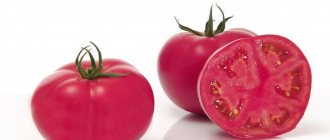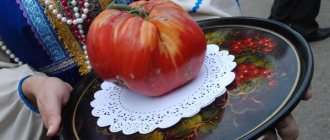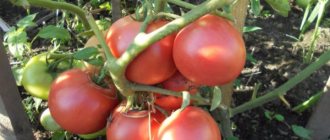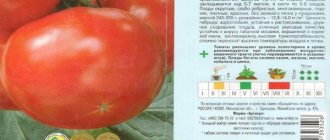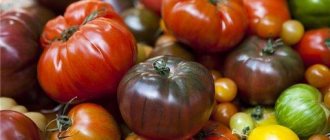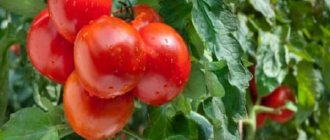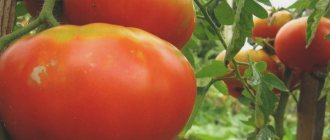Hybrid Overture F1 will appeal to lovers of small tomatoes, which can be used for making salads and pickling in their entirety. The main consumer advantages of the cultivar are its sweet taste when fresh and the ability not to crack during heat treatment.
| Height | Landing location | Ripening time | Fruit color | Fruit size | Origin | Fruit shape |
| Tall | Greenhouse | Mid-season | Reds | Average | Hybrid | Round |
Main characteristics of the variety
- Early ripening (fruits can be harvested 100-110 days after sowing the seeds).
- Suitable for growing both in open ground and in greenhouses.
- Hybrid variety - when re-growing from collected own seeds, there is no guarantee of repeating the properties and qualities of the mother plant.
- Indeterminant - therefore, during the growing process, constant pinching of the bushes will be required.
- Excellent yield: it is possible to collect up to 6 kg of fruit from a bush, and up to 25 kg per square meter with proper care.
- Tall variety: in closed ground reaches 1.8 meters in height. When open it grows slightly lower - up to 1.3 m.
- The bushes are weakly leafy, with powerful stems, and require obligatory gartering to a support.
- The fruits are small, each weighing up to 120-150 g, which allows them to be used not only in fresh salads, but also for pickling as a whole.
- Ripe fruits, if necessary, can be left on the bushes without removing them for 10 days.
- The texture of the fruits is quite strong; with accidental overwatering, the fruits, like some other varieties, do not crack.
- The tomato is not affected by cladosporiasis, veticillium, or tobacco mosaic virus.
Advice!
To reap the greatest harvest, it is preferable to form a bush with no more than 1-2 trunks. Fact!
- The trick of this variety is that its fruits can remain marketable for quite a long time. Without creating special conditions (for example, outdoors in boxes), they are perfectly stored for four weeks.
- The variety also has one more advantage. Those who grow Overture for sale will be able to appreciate it. The fruits sit firmly on their “legs” in the tomato clusters. And implementing them in this form is much more presentable.
Review of semi-determinate tomatoes
Tomatoes of the semi-determinate group, in their characteristics, are something between determinate and indeterminate varieties. The bushes grow up to 1.5 m in height, but can also be low. The crop is characterized by high productivity, versatility in the use of fruits and an open type of cultivation. However, there are semi-determinate tomatoes that bear fruit well in greenhouse conditions. Let's look at the description and photos of some productive tomatoes in this group.
Lilac Lake
The culture is adapted for open and closed cultivation. The slightly spreading bush grows up to 1 m in height outdoors, and 1.5 m in a greenhouse. The stem is secured to a trellis or any support; excess shoots must be removed so that 2 or 3 stems are formed. The vegetable has an unusually beautiful lilac-colored skin with small dots resembling pearls. Inside the pulp is raspberry. Tomatoes grow quite large, weighing up to 350 g. Despite the high density of the pulp, it can crack. The vegetable is considered a salad type.
Serbian heart
The method of growing the variety depends on weather conditions. In the southern regions, growing this tomato in open areas is acceptable; for the middle zone, the greenhouse method is recommended. The stem of the plant extends up to 1.5 m in height. The bush is fixed to the trellis and formed with 2 or 3 stems. Pink, fleshy fruits weigh 250 g. The good taste of the pulp and low seed content have made the tomato popular in salads, as well as freshly squeezed juices.
The video talks about the Serbian Heart variety:
Verna
In the southern regions, the crop yields up to 10 kg of tasty tomatoes per plant. In the middle zone, only greenhouse cultivation is permissible. The mid-season variety has gained great popularity due to the value of the fruit from which baby food is prepared. The vegetable stores well and can be frozen. The stem of the plant extends up to 1.5 m in height. The fruits resemble large plums. The orange vegetable weighs a maximum of 200 g.
Cardinal
The variety will delight you not only with a high yield, but also with large fruits. It is grown in open and closed ways depending on the climatic conditions of the region. The stem of the plant can stretch up to 1.7 m, although it is often limited to a height of 1.2 m. The bushes are fixed to the trellis; the pinching process is aimed at forming the bush with 1 or 2 stems. The shape of the pink tomato resembles a heart. The sweet pulp contains few seeds. The vegetable weighs about 500 g. 5 kg of tomatoes are harvested from 1 plant per season.
Chinese pink
Greenhouse conditions are optimal for growing the crop. Bushes 1.5 m high show good yield results when formed with 2 stems. A pink vegetable in the shape of an even heart weighs up to 350 g. A small number of grains are observed inside the fleshy pulp. Sweet tomato is very tasty in salads.
Summer cider
In terms of ripening time, the tomato belongs to the mid-season varieties. The main stem of the plant reaches 1.5 m in height. The culture is able to adapt and produce good yields in open and closed beds. The bush is formed with 2 or 3 stems, securing it to the trellis as it grows. Large orange spherical fruits weigh 400 g. On the lower tiers of the bush grow giants weighing 800 g. The sweet, fleshy pulp is suitable for dietary nutrition and making salads.
Mom's love
Tomatoes are grown in closed and open beds, but for the middle zone greenhouse growth is desirable. According to the ripening period, the crop is considered mid-season. A bush with a height of 1.5 m is capable of producing the maximum amount of harvest when formed with 2 stems. The plant produces a lot of tomatoes. A ripe vegetable acquires a red flesh color. The tomatoes are large, weighing up to 500 g. There are very few grains inside the sweet pulp.
Pre-sowing preparation
- A good effect is obtained by freezing the seeds before sowing in the freezer for 1 week. If you don’t have that much time, it is advisable to put it in the freezer for at least two days.
- On the eve of sowing, the seeds will also benefit from soaking. The simplest option is in solutions of purchased biostimulants - “Epina”, “NV-101”, “Ecosila”.
- A good effect is achieved by soaking in an aqueous solution of aloe juice (1:2). A week before use, an aloe vera leaf should be placed in the vegetable compartment of the refrigerator so that the beneficial substances in it are activated.
- Garden soil, sand, purchased soils from which the soil mixture is prepared for sowing seeds must first be disinfected - at least spilled with boiling water. The best option is to refill with the Fitosporin solution (for detailed instructions, see the instructions for the drug).
Sowing seeds
It is better to sow immediately in separate containers so that the roots are not injured during transplantation. Peat cups are ideal; with them, the seedlings can then be “relocated” into the soil of a greenhouse or vegetable garden. At the same time, it is important to water the plantings generously in the first weeks so that the peat cups get wet, thereby allowing the plant’s root system to spread along the soil horizons.
Important Terms
In order for seedlings to grow strong and healthy, you need to know and take into account the basic nuances of caring for them.
- A location with sufficient light, ideally on window sills facing southwest and southeast.
- On too sunny days or in the midday heat (on a southern windowsill), the seedlings should be shaded. Even ordinary sheets of paper installed as a screen between the window glass and young plants will help them not to get burned or become weak.
- Sufficient air humidity (at least 60%). Regular daily spraying of seedlings from a spray bottle will help keep it that way.
- Careful watering. Seedlings should not be overwatered - this threatens the development of a disease such as “black leg”, and they should not be overdried - the root system will dry out, and as a result the plant will die.
- If necessary, pick in the phase of the first pair of true leaves.
- In the same phase (after picking) - fertilizing with complex mineral fertilizer in half the dose recommended in the instructions attached to the preparation.
- Before planting seedlings in open ground, it would be good to harden them. First, for a very short period of time, then increasing it more and more, the seedlings are taken out into the open air (in the garden or on the balcony). On the eve of planting, it is useful to train tomato seedlings to spend the night in the greenhouse. This way they will get used to the new atmosphere in which they will have to develop in the future, and the process of adaptation to new conditions will be much less painful.
Advice!
As the seedlings grow, it is a good idea to treat them with biostimulants (for example, the drug “NV-101”) once every two weeks. This will activate the plants' defenses, strengthen their immunity and accelerate growth.
How to grow tomatoes of this variety
The hybrid tomato Overture produces a bountiful harvest with relatively simple agrotechnical practices. It has long taken a strong place in the beds of experienced vegetable growers due to a number of its inherent advantages.
The characteristics and description of the variety, which are reflected in the State Register of the Russian Federation, allow us to highlight the following features of the tomato:
- refers to early ripening vegetable crops, since the fruits ripen within 100-110 days from the moment the seeds are sown;
- bushes of indeterminate type reach a height of 1.5 m;
- the plant is strong, powerful, with a small amount of foliage;
- fruits on 1 cluster ripen almost simultaneously;
- the yield from 1 bush is about 6 kg (24 kg can be harvested from 1 m²);
- the taste of tomatoes is sweet;
- the pulp contains a lot of dry matter;
- tomatoes are covered with thick skin, which prevents them from cracking and allows them to remain intact;
- the variety has high rates of transportation over various distances.
READ MORE: Mysterious thistle, what it looks like, photos and pictures || Thistle photo plants description types and care features
After the crop is harvested, it is placed in a cool, dry place.
Among the undoubted advantages of this hybrid variety is its resistance to diseases, including verticillium, fusarium and a number of others.
Overture tomatoes can be planted both in open ground and under film covers.
You should buy seeds from a trusted supplier to avoid disappointment later due to poor germination.
Seeds are prepared in advance, removing low-quality ones. After this, the seed material is placed in gauze and kept in a solution of potassium permanganate for about 20 minutes, which disinfects it. Next, it needs to be strengthened with a growth stimulator. To do this, it is immersed in the appropriate preparation for 2-3 hours.
Sometimes seedling material needs to be hardened: first it is placed in warm water for 30 minutes, and then transferred to the bottom shelf of the refrigerator, where it is left for 2 days.
To get healthy seedlings, they must be watered moderately and fed with mineral and organic fertilizers in optimal quantities.
If the region experiences short daylight hours, then the lighting in the room with the seedlings should be increased. They also need warmth, so temperature changes are unacceptable.
Picking of young bushes is carried out after the appearance of 2 true leaves.
After 60-65 days, the tomato seedlings are transferred to a permanent place of growth.
In an open area, seedlings are planted only when the ground temperature is about 10 °C (beginning or mid-May). Overture tomatoes can be used on site for compaction, planting them, for example, in beds with early varieties of cabbage.
Place tomato bushes at a distance of 50-60 cm from each other. 3 or 4 bushes are placed per 1 m².
When growing Overture NK f1 tomatoes outdoors, the following recommendations should be followed:
- during the formation of ovaries, water 1 m² of land with bushes with 3 liters of water;
- make the first fertilizing 10 days after planting the seedlings in the ground; subsequent ones – once every 2 weeks;
- remove weeds as they appear and regularly loosen the soil;
- tie up plants as they grow;
- form tomato bushes into one or two stems.
With proper agricultural technology in open ground, the yield of the Overture variety is higher than in closed ground.
Seedlings are transferred to indoor soil in late April-early May. The soil in which you plan to plant young tomato bushes should be warmed by laying fresh manure on it and watering it with boiling water. After this, soil 20 cm thick is distributed over the fertilizer. Tall bushes are sent deeper into the ground.
- Tomatoes Overture f1 need to be tied up, so when planting seedlings, pegs are driven in next to them or a trellis is installed above them.
- As the tomato bush grows, the shoots are broken off from it. The main principle of caring for a tomato during its cultivation is compliance with the optimal watering and feeding regime.
- When the fruits begin to turn red, they can already be removed from the bush. Ripe tomatoes can remain on the bush for about 10 more days. They are not afraid of rotting or cracking.
Reviews from experienced gardeners indicate that tomatoes of this variety ripen in greenhouses a week earlier than in open ground.
Overture tomatoes are often planted by farmers for the purpose of subsequent sale. But summer residents also appreciated a number of advantages inherent in this type of tomato, which is why these tomato bushes are increasingly found in the personal plots of amateurs.
Hybrid Overture F1 will appeal to lovers of small tomatoes, which can be used for making salads and pickling in their entirety. The main consumer advantages of the cultivar are its sweet taste when fresh and the ability not to crack during heat treatment.
| Height | Landing location | Ripening time | Fruit color | Fruit size | Origin | Fruit shape |
| Tall | Greenhouse | Mid-season | Reds | Average | Hybrid | Round |
The Overture variety feels great under film coverings and in the open air.
At any place where a vegetable is planted, it is necessary to sow tomatoes for seedlings. Seeds are prepared in advance, rejecting low-quality ones. Then the seed material is placed in a gauze bag, immersed in a solution of potassium permanganate for twenty minutes. Similarly, place the seeds in a growth stimulator for two to three hours. If they need to be hardened, they will first stay in warm water for half an hour, and then on the bottom shelf of the refrigerator for a day or two. Treated tomato seeds are ready for planting.
READ MORE: Belladonna - medicinal properties of the plant and recipes for preparing belladonna
They are buried one centimeter inside the soil, which has been disinfected with boiling water or a solution of potassium permanganate. The distance between the holes in the box should not be less than three centimeters, otherwise the seedlings will not have enough nutrients for development.
For seedlings to grow healthy and strong, they need:
- water moderately;
- feed with superphosphate, potassium salt or mullein;
- illuminate with fluorescent lamps during short daylight hours;
- keep warm;
- dive after two true leaves appear.
As soon as the seedlings are 60-65 days old, they must be transplanted to a permanent place.
To get healthy seedlings, they must be watered moderately and fed with mineral and organic fertilizers in optimal quantities. If the region experiences short daylight hours, then the lighting in the room with the seedlings should be increased. They also need warmth, so temperature changes are unacceptable. Picking of young bushes is carried out after the appearance of 2 true leaves.
Planting in a greenhouse and open ground
- The scheme for planting seedlings is 40x50 cm, otherwise - 4 plants per 1 sq.m.
- By the time of planting in the ground, the soil temperature should remain stable at no lower than +10 degrees.
- In open ground, for the first 1-2 weeks (until they take root well), seedlings should be covered, for example, with spunbond.
- The soil must be prepared in the fall: improved by applying horse manure or complex mineral fertilizers (in the dosage specified in the instructions for them). As an alternative, you can add rotted manure or compost to the bottom of the planting hole. At the same time, in the future you will have to be more careful with the application of organic fertilizers. It is important not to overdo it with them: otherwise the green mass will develop rapidly to the detriment of fruit setting and ripening.
- You will have to tie up the tomatoes immediately and then do this again and again as the bushes grow.
- You should start pinching after the formation of the first flower cluster. Below it, all the leaves are plucked out. Leave a maximum of two main stems.
- You need to water generously, but not excessively. After watering, ventilate the greenhouse well.
- During the flowering period, for better formation of ovaries, it is useful to spray with a solution of boric acid (1 g of the drug per 1 liter of warm water).
- To protect against late blight, it would be a good idea to spray the bushes with whey.
Description and characteristics of the tomato Overture F1, reviews, photos
Early ripening (101-112 days from germination to ripening), high-yielding, indeterminate tomato hybrid. Recommended for cultivation in open ground and in greenhouses.
The plant is slightly leafy, 1.5-1.8 meters high, with a strong, powerful stem. Requires tying to the support and pinning. The best results were obtained when forming a plant with 1 or 2 stems. The first inflorescence is laid above the 8-9 leaf.
The fruits are round, dense, red at maturity without a green spot on the stalk, weighing up to 130 grams, fleshy, good (for a hybrid) taste. Not prone to cracking, durable and transportable.
Advantages of the hybrid: high yield and marketability of fruits, suitability for collection and sale in clusters. Once fully ripe, the fruits can be left on the plant for 10 days. Ripe fruits are stored for up to 4 weeks in unregulated conditions.
The hybrid is resistant to tobacco mosaic virus, verticillium, and cladosporiosis.
Planting pattern: 50 x 40 cm, planting density: 3-4 plants per 1 sq. m.
Productivity: up to 23.4 kg per 1 square meter of planting (with watering and fertilizing).
If you grew Overture F1 tomatoes, please write what the yield and taste of the fruit were in your climatic conditions. If possible, attach to the comment a photo of the entire bush as a whole or individual fruits that you grew.
Your reviews about the Overture tomato and additions to the description will help many gardeners evaluate this tomato more objectively and decide whether it is worth planting or not.
Among the high-yielding vegetable plants, one can note the Overture F1 tomato, which belongs to the indeterminate hybrids. In addition to abundant harvests, the variety has many different advantages that give it the right to take its rightful place in the garden bed or greenhouse.
Last year I grew an Overture tomato both in an open garden bed and in a greenhouse. She noted: in a greenhouse, the fruits ripen a week and a half earlier, the bushes grow taller, so the yield from each is higher. I was a little surprised that growing in a greenhouse does not affect the size of the fruit. Greenhouse tomatoes did not seem larger to me than those grown in open ground.
Larisa Viktorovna
From my point of view, this is an ideal variety of greenhouse tomatoes. I don’t know who came up with the idea that small fruits are only suitable for pickling; a salad made from them is excellent! I moved the first batch of seedlings into the greenhouse at the end of April, the second in early March. It’s funny, but in the very near future the second batch overtook the first in growth and “soloed” the first harvest earlier.
At the beginning of July, I removed the first box of pink fruits so that the next ones would ripen faster and more ovaries could form during the season. I put the box in a cool place - the tomatoes remained strong and pink for a long time. From mid-July to mid-August, a box of tomatoes could be harvested every week. A very productive variety!
By the way, our family finished the last fresh “Overturk” tomatoes in December!
READ MORE: Tomato Superstar - description and characteristics of the variety
Viktor Timofeevich
- Nina
City: TyndaManufacturer: Russian Garden
Where grown: Greenhouse
A good hybrid, stable, knits tassels even in the conditions of our northern region with large temperature differences. Always with the harvest. The taste of the fruit is tomato, sour, aromatic. Good for pickling. The seeds sprouted quickly and amicably. It is necessary to tie the brushes so that they do not bend under the weight of the tomato. I grow it in two stems. I plant the seeds at the end of February. In the greenhouse in early May.
- Elena
Penza cityManufacturer: Russian Garden
Where grown: Open ground
This is my second year growing it. They always take a very long time to sprout, in 2021 I waited a month! Everyone has ascended. The taste is wonderful, the yield is uneven, the bush is good, the bush is bad.
- Natalia
Krasnodar cityManufacturer: Russian Garden
Where grown: Open ground
I’ve been growing it for the first year, sowed seedlings on March 15, and at the end of June I received the first ripe fruits. Everything corresponds to the description. It ties great! At the moment, 6 full-fledged brushes of 6-7 pieces are tied on one trunk. I liked the taste.
- Lyudmila
City: St. PetersburgManufacturer: Russian Garden
Where grown: Greenhouse
I planted it for 2 years, now I bought the seeds again and planted seedlings, the tomatoes are delicious, they last a long time, I like the variety!

